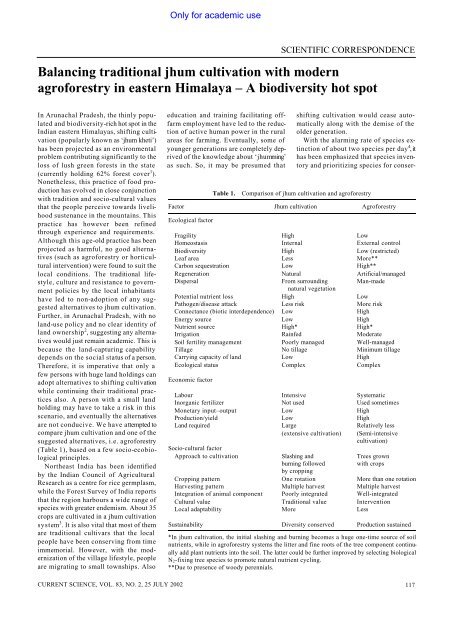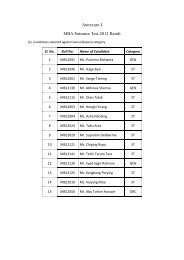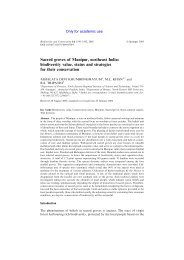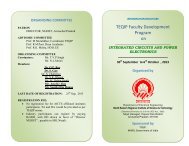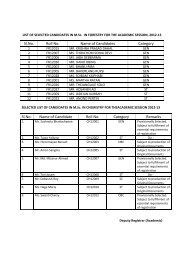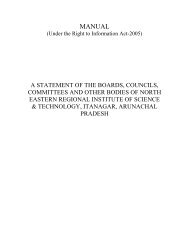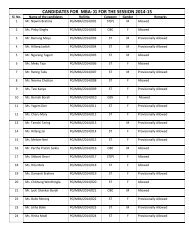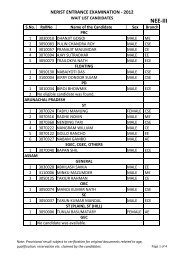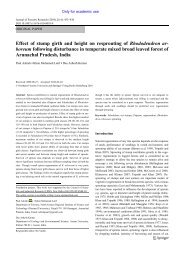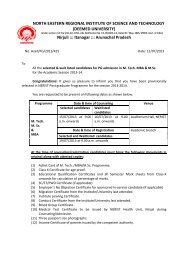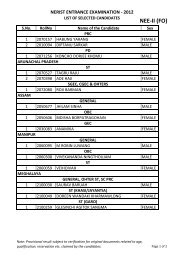Balancing traditional jhum cultivation with modern ... - NERIST
Balancing traditional jhum cultivation with modern ... - NERIST
Balancing traditional jhum cultivation with modern ... - NERIST
You also want an ePaper? Increase the reach of your titles
YUMPU automatically turns print PDFs into web optimized ePapers that Google loves.
SCIENTIFIC CORRESPONDENCE<br />
<strong>Balancing</strong> <strong>traditional</strong> <strong>jhum</strong> <strong>cultivation</strong> <strong>with</strong> <strong>modern</strong><br />
agroforestry in eastern Himalaya – A biodiversity hot spot<br />
In Arunachal Pradesh, the thinly populated<br />
and biodiversity-rich hot spot in the<br />
Indian eastern Himalayas, shifting <strong>cultivation</strong><br />
(popularly known as ‘<strong>jhum</strong> kheti’)<br />
has been projected as an environmental<br />
problem contributing significantly to the<br />
loss of lush green forests in the state<br />
(currently holding 62% forest cover 1 ).<br />
Nonetheless, this practice of food production<br />
has evolved in close conjunction<br />
<strong>with</strong> tradition and socio-cultural values<br />
that the people perceive towards livelihood<br />
sustenance in the mountains. This<br />
practice has however been refined<br />
through experience and requirements.<br />
Although this age-old practice has been<br />
projected as harmful, no good alternatives<br />
(such as agroforestry or horticultural<br />
intervention) were found to suit the<br />
local conditions. The <strong>traditional</strong> lifestyle,<br />
culture and resistance to government<br />
policies by the local inhabitants<br />
have led to non-adoption of any suggested<br />
alternatives to <strong>jhum</strong> <strong>cultivation</strong>.<br />
Further, in Arunachal Pradesh, <strong>with</strong> no<br />
land-use policy and no clear identity of<br />
land ownership 2 , suggesting any alternatives<br />
would just remain academic. This is<br />
because the land-capturing capability<br />
depends on the social status of a person.<br />
Therefore, it is imperative that only a<br />
few persons <strong>with</strong> huge land holdings can<br />
adopt alternatives to shifting <strong>cultivation</strong><br />
while continuing their <strong>traditional</strong> practices<br />
also. A person <strong>with</strong> a small land<br />
holding may have to take a risk in this<br />
scenario, and eventually the alternatives<br />
are not conducive. We have attempted to<br />
compare <strong>jhum</strong> <strong>cultivation</strong> and one of the<br />
suggested alternatives, i.e. agroforestry<br />
(Table 1), based on a few socio-ecobiological<br />
principles.<br />
Northeast India has been identified<br />
by the Indian Council of Agricultural<br />
Research as a centre for rice germplasm,<br />
while the Forest Survey of India reports<br />
that the region harbours a wide range of<br />
species <strong>with</strong> greater endemism. About 35<br />
crops are cultivated in a <strong>jhum</strong> <strong>cultivation</strong><br />
system 3 . It is also vital that most of them<br />
are <strong>traditional</strong> cultivars that the local<br />
people have been conserving from time<br />
immemorial. However, <strong>with</strong> the <strong>modern</strong>ization<br />
of the village lifestyle, people<br />
are migrating to small townships. Also<br />
education and training facilitating offfarm<br />
employment have led to the reduction<br />
of active human power in the rural<br />
areas for farming. Eventually, some of<br />
younger generations are completely deprived<br />
of the knowledge about ‘<strong>jhum</strong>ming’<br />
as such. So, it may be presumed that<br />
shifting <strong>cultivation</strong> would cease automatically<br />
along <strong>with</strong> the demise of the<br />
older generation.<br />
With the alarming rate of species extinction<br />
of about two species per day 4 , it<br />
has been emphasized that species inventory<br />
and prioritizing species for conser-<br />
Table 1. Comparison of <strong>jhum</strong> <strong>cultivation</strong> and agroforestry<br />
Factor Jhum <strong>cultivation</strong> Agroforestry<br />
Ecological factor<br />
Fragility High Low<br />
Homeostasis Internal External control<br />
Biodiversity High Low (restricted)<br />
Leaf area Less More**<br />
Carbon sequestration Low High**<br />
Regeneration Natural Artificial/managed<br />
Dispersal From surrounding Man-made<br />
natural vegetation<br />
Potential nutrient loss High Low<br />
Pathogen/disease attack Less risk More risk<br />
Connectance (biotic interdependence) Low High<br />
Energy source Low High<br />
Nutrient source High* High*<br />
Irrigation Rainfed Moderate<br />
Soil fertility management Poorly managed Well-managed<br />
Tillage No tillage Minimum tillage<br />
Carrying capacity of land Low High<br />
Ecological status Complex Complex<br />
Economic factor<br />
Labour Intensive Systematic<br />
Inorganic fertilizer Not used Used sometimes<br />
Monetary input–output Low High<br />
Production/yield Low High<br />
Land required Large Relatively less<br />
(extensive <strong>cultivation</strong>) (Semi-intensive<br />
<strong>cultivation</strong>)<br />
Socio-cultural factor<br />
Approach to <strong>cultivation</strong> Slashing and Trees grown<br />
burning followed<br />
<strong>with</strong> crops<br />
by cropping<br />
Cropping pattern One rotation More than one rotation<br />
Harvesting pattern Multiple harvest Multiple harvest<br />
Integration of animal component Poorly integrated Well-integrated<br />
Cultural value Traditional value Intervention<br />
Local adaptability More Less<br />
Sustainability Diversity conserved Production sustained<br />
*In <strong>jhum</strong> <strong>cultivation</strong>, the initial slashing and burning becomes a huge one-time source of soil<br />
nutrients, while in agroforestry systems the litter and fine roots of the tree component continually<br />
add plant nutrients into the soil. The latter could be further improved by selecting biological<br />
N 2-fixing tree species to promote natural nutrient cycling.<br />
**Due to presence of woody perennials.<br />
CURRENT SCIENCE, VOL. 83, NO. 2, 25 JULY 2002 117
SCIENTIFIC CORRESPONDENCE<br />
vation are inevitable for human existence<br />
in this planet. Also, geneticists believe<br />
that wild relatives of cultivated species<br />
and the <strong>traditional</strong> crops have a wide<br />
variety of genetic diversity 5 , some of<br />
them still remaining to be screened.<br />
Bawa and Dayanandan 5 also stated that<br />
deforestation and fragmentation pose<br />
more serious challenges to biodiversity<br />
and wild genetic resources than climatic<br />
change. Thus, whether we need to go for<br />
improved production or conserve existing<br />
crop diversity in shifting <strong>cultivation</strong><br />
remains a dilemma. The increasing attention<br />
to <strong>traditional</strong> ecological knowledge<br />
and practices 6 embedded in any land use<br />
by the people living in the mountains is<br />
especially crucial in the hilly state of<br />
Arunachal Pradesh, where the soil is<br />
geologically young, highly leached and<br />
prone to frequent landslides and erosion<br />
in the hills and floods in the foothills 7 .<br />
The political development and strengthening<br />
of the government have led to the<br />
transfer of powers and authority from<br />
<strong>traditional</strong> leaders to government or political<br />
officials, who constitute a new<br />
elite. Yet, imposition of shifting <strong>cultivation</strong><br />
regulation Act 1947 or the ban on<br />
timber-logging has not helped in improvement<br />
or rehabilitation of the <strong>jhum</strong><br />
lands 8 . A few farmers have, however,<br />
gone for terracing the <strong>jhum</strong> fields on the<br />
slopes and some have adopted horticultural<br />
plantations. But again, lack of infrastructure<br />
for marketing has led to<br />
devastation of the excess produce. Our<br />
own field observations and personal interviews<br />
<strong>with</strong> the village heads who<br />
adopted horticultural rehabilitations of<br />
<strong>jhum</strong> lands through Citrus plantations<br />
reveal that most of their produce (ca.<br />
80%) rot due to lack of storage and/or<br />
marketing facilities.<br />
Further, in the context of sustainability,<br />
which is a bondage between conservation<br />
and production, it is important<br />
that location-specific, highly economic<br />
improvements need to be amended into<br />
the ongoing shifting <strong>cultivation</strong> practice<br />
to bestow sedentary farming in the long<br />
run 9 . Under this contention, <strong>jhum</strong> <strong>cultivation</strong><br />
seems to better conserve the<br />
diversity of crops compared to the <strong>modern</strong><br />
agroforestry where production has<br />
been projected to be better. While the<br />
former remains a labour-intensive but<br />
monetarily economic practice of food<br />
production, systematic labour and money<br />
inputs are required for managing the<br />
latter system. Also the agroforestry system<br />
does not get quick and continued<br />
support in tribal settings. From a forestry<br />
viewpoint, natural regeneration is promoted<br />
in the <strong>jhum</strong> fields after abandonment,<br />
while carbon sequestration can be<br />
higher in the tree component of the agroforestry<br />
system.<br />
With the growing human population,<br />
greater ethnic diversity, loss of forest<br />
cover, decreasing shifting <strong>cultivation</strong>,<br />
changing rural lifestyle, expanding townships,<br />
ban on timber-logging and increasing<br />
dependence on rice and vegetables;<br />
Arunachal Pradesh would run into trouble<br />
in terms of food security 10 , as most<br />
existing production systems are less productive<br />
(e.g. 10.14 quintals/ha of rice<br />
production), but the shifting <strong>cultivation</strong><br />
harbours greater crop/genetic diversity.<br />
Thus, the challenge lies in providing a<br />
minimum of <strong>traditional</strong> practices of <strong>jhum</strong><br />
and <strong>modern</strong> agroforestry.<br />
Therefore, it is important that the state<br />
constitutes its land-use policy and implements<br />
the same strategically for better<br />
land management and also to support the<br />
growing livelihood requirements of the<br />
residents. Further, farmer’s innovations<br />
need to be recognized and scientific<br />
ideas need to be built upon them for improvement<br />
of shifting <strong>cultivation</strong> 11 . For<br />
instance, recognition and incentives<br />
should be provided to <strong>traditional</strong> farmers<br />
ameliorating agroforestry. This may help<br />
in balancing between biodiversity conservation<br />
and economic growth. In this<br />
regard, a farmer-led extension programme<br />
would prove viable to rehabilitate<br />
the <strong>jhum</strong> lands <strong>with</strong>out hurting the<br />
<strong>traditional</strong> will and sentiments of the<br />
local people. For example, in Nagaland,<br />
local people have adopted growing of<br />
alder trees in <strong>jhum</strong> lands that has contributed<br />
to the soil nutrient enrichment<br />
and crop production 9 . However, in Arunachal<br />
Pradesh, this strategy has not been<br />
adopted due to lack of land tenure system.<br />
Such a farmer-led approach may<br />
also help in conservation of crop diversity<br />
as well as enrichment of crop<br />
production, instead of an external intervention<br />
that may not be successfully<br />
absorbed by the people.<br />
1. Singh, S., A Resource Atlas of Arunachal<br />
Pradesh, Government of Arunachal<br />
Pradesh, Itanagar, 1999, p. 161.<br />
2. Bakshi, P. M. and Kusum, Land System<br />
of Arunachal Pradesh, N. M. Tripathi<br />
Pvt Ltd, Mumbai, 1989, p. 175.<br />
3. Ramakrishnan, P. S., Man India, 1985,<br />
65, 1–32.<br />
4. Bawa, K. S. and Ashton, P., in Genetics<br />
and Conservation of Rare Plants (eds<br />
Falk, D. A. and Holsinger, K. E.),<br />
Oxford University Press, 1998, pp. 62–<br />
71.<br />
5. Bawa, K. S. and Dayanandan, S., Climatic<br />
Change, 1997, 39, 473–485.<br />
6. Berkes, F., Colding, J. and Folke, C.,<br />
Ecol. Appl., 2000, 10, 1251–1262.<br />
7. Kumar, G., Geology of Arunachal<br />
Pradesh, Geological Society of India,<br />
Bangalore, 1997, p. 217.<br />
8. Chawii, L., Down to Earth, 2002, pp.<br />
54–55.<br />
9. Ramakrishnan, P. S., Shifting Agriculture<br />
and Sustainable Development, MAB<br />
Series UNESCO-Parthenon, 1992, vol.<br />
10, p. 424.<br />
10. Maithani, B. P., Administrator, 1997,<br />
XLII, 177–183.<br />
11. Mashelkar, R. A., 16th Dr C. D.<br />
Deshmukh Memorial Lecture, India<br />
International Centre, New Delhi, 14<br />
January 1999.<br />
Received 26 March 2002; revised accepted 11<br />
June 2002<br />
A. ARUNACHALAM*<br />
M. L. KHAN<br />
K. ARUNACHALAM<br />
Department of Forestry,<br />
North Eastern Regional Institute<br />
of Science and Technology,<br />
Nirjuli 791 109, India<br />
*For correspondence.<br />
e-mail: aa@agni.nerist.ac.in<br />
118<br />
CURRENT SCIENCE, VOL. 83, NO. 2, 25 JULY 2002


